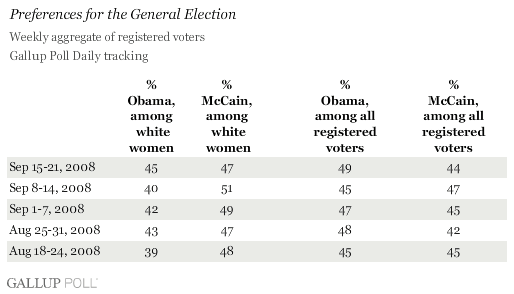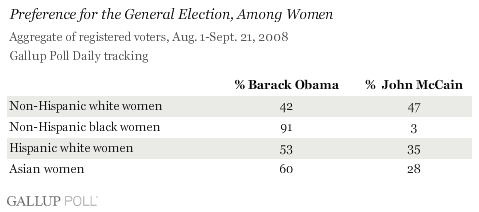PRINCETON, NJ -- Did John McCain's selection of Sarah Palin as his vice presidential running mate lead to significant gains for McCain among white women? While this hypothesis fits easily into the media's coverage and the excitement around Palin's historic status as the first female Republican vice presidential candidate, continuing analysis of large Gallup Poll Daily tracking samples from recent weeks do not provide evidence to support it.
Gallup Daily tracking has shown some variation in support levels for the two candidates -- McCain and Barack Obama -- across the last month and a half, but the shifts in candidate preferences of white women do not appear to have been much different from those of all voters.

By the week of Sept. 15-21, a rising tide for Obama had in general lifted his strength among white women as much as it did among everyone else. Obama ended last week in a slightly stronger position among white women than was the case as the political conventions began -- in fact, coming within 2 points of McCain.
White Men More of a Problem for Obama Than White Women
From a more general perspective, Obama continues to do less well among white women than he does among women of other racial or ethnic backgrounds.
An aggregate of more than 23,000 interviews Gallup conducted with female registered voters between Aug. 1 and Sept. 21 shows McCain leading Obama by 47% to 42% among all white women, while McCain loses significantly among black, Hispanic, and Asian women.

Thus, although Obama has a problem among all white voters, in the sense that he loses among them to McCain, his relative standing among white women is certainly better than it is among white men.
Discussion
It has been well-established that Obama does not do as well among white women as he does among Hispanic, black, and Asian women.
This fact, however, predates McCain's selection of Palin as his running mate. The data reviewed here suggest that Palin's presence on the GOP ticket did not appear to shift white women disproportionately toward McCain, nor did it appear to engender more loyalty to McCain among white women over the past week when the general trend was toward Obama. As is true for the entire electorate, McCain now is doing slightly less well among this group than he did before the two conventions began.
More generally, commentators who opine that Obama has a problem among white women are correct as far as that goes. Obama does less well among whites in general and less well among white women than among women of other racial and ethnic backgrounds.
However, commentators would be perhaps more on target by pointing out Obama's larger problem among white men, among whom he is losing by 35% to McCain's 56%.
And, of course, white women are not a monolithic voting group. There are big differences in the level of support given to both candidates within subgroups of the white female population. For example, data show that Obama has significant problems among white women who are not college graduates -- among whom he has been losing to McCain by a 50% to 37% margin over the last month and a half -- and among married white women, among whom McCain has been winning by a 17-point margin, 54% to 37%.
Survey Methods
Results are based on telephone interviews with 47,087 registered voters, aged 18 and older, conducted Aug. 1-Sept. 21, 2008. For results based on the total sample of registered voters, one can say with 95% confidence that the maximum margin of sampling error is ±1 percentage points. Margins of sampling errors vary for individual subsamples.
Interviews are conducted with respondents on land-line telephones (for respondents with a land-line telephone) and cellular phones (for respondents who are cell-phone only).
In addition to sampling error, question wording and practical difficulties in conducting surveys can introduce error or bias into the findings of public opinion polls.
To provide feedback or suggestions about how to improve Gallup.com, please e-mail feedback@gallup.com.
